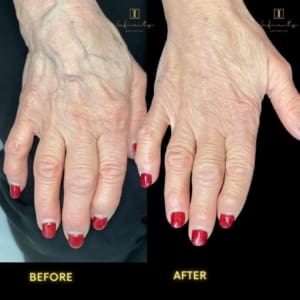How Does Dermal Filler Stay in Place?
When you book for dermal filler injections, you may be concerned about filler migration. Recently becoming something of a hot-topic on social media, there are a number of myths that have been circulating about dermal fillers and their ability to move under the skin. However, it is very rare that filler migration occurs naturally. So, how does dermal filler stay in place?
When injected under the skin, dermal fillers that contain hyaluronic acid will remain firmly in place for between 6-18 months. This is due to molecules in the filler that coil up when inserted into the skin, causing them to become integrated with collagen and elastin in the skin, thus preventing the filler from moving.
Keep reading to find out more about how dermal fillers stay in place, and what can cause them to migrate.
What Makes Dermal Filler Stay in Place?
Most aesthetic clinics will use dermal fillers that contain hyaluronic acid, a substance that naturally occurs in the body. When the filler product is injected into the area to be treated, such as the lips, a molecule that is in the filler injection begins to coil upon entering the skin. The integration between the coiled filler molecules and the collagen and elastin in the skin results in the dermal filler remaining firmly in place. Once dermal filler has been injected into the carefully-selected area, it will typically remain in place for between 12 and 24 months.
What Causes Dermal Fillers to Break Down?
Over time, the results of the treatment will become less and less noticeable, and areas of skin that you had treated with dermal filler may require a top-up injection. This is because as hyaluronic acid is a biodegradable substance, over time, the body metabolises the filler with the enzyme hyaluronidase. If the treatment of receiving dermal fillers causes an adverse reaction, the filler can be broken down quickly using an injection of hyaluronidase.
Can Filler Migrate?
There are some common myths that surround dermal filler treatments, including filler migration. Some people are so worried about filler migration following their treatment that they are afraid to touch their face (if this is where they have received the filler) as they are worried that it will move their fillers. In fact, dermal filler migration is very rare, especially when compared to more permanent fillers such as silicone that are more likely to migrate due to their long-term presence in the body. In many facial areas, filler is placed deeply under muscle into the fat pads, where it is unlikely to move. In areas of high movement migration is more likely and this particularly can be seen with overfilled lips.
Why Does Filler Migrate?
It is important to remember that filler migration of any kind is very rare. However, there are certain steps that can be taken during the treatment process that can make migration more or less likely to occur. Included below are some of the key factors that can result in filler migrating.
Poor Technique
As dermal filler treatments have become more popular in recent years due to it being minimally-invasive with immediate results, there has also been the rapid growth of inexperienced clinicians offering the treatment at lower prices. With lower prices also comes a lower quality of treatment and, in the case of dermal fillers, can lead to filler migration.
For example, injecting filler too quickly can put excessive pressure on the injection site which increases the likelihood that the filler will migrate. An experienced clinician will also be able to develop a detailed picture of your anatomy to ensure that filler is being placed in the precise location to deliver the best results without migration occurring.
Overfilling
Inexperienced injectors are more likely to get the amount of filler wrong when injecting. If you were to receive too much dermal filler in the lips, it can cause the product to migrate up and out from the upper lip, leaving bumpy skin behind.
Frequency of Injection
Another mistake of inexperienced injectors is to perform multiple injections in the space of a few days. This can cause overfilling and the skin becomes too heavy too quickly, often resulting in the filler migrating. An experienced clinician will leave a few weeks between appointments to ensure the filler has had time to settle.
Immune Response
It is normal to experience some minor redness and swelling at the site of injection after receiving dermal fillers. However, in some rare cases, the body’s immune system may react poorly to the injection which can trigger extreme swelling. This is often due to an allergic reaction, illness or a vaccine, but it can cause filler to move slightly.
Aftercare
Once you have received dermal filler treatment, the temptation might be to try and massage the area to smooth the filler. In actual fact, touching the site of injection too much can cause the filler to migrate. Not only this, but bacteria will also be able to enter your skin via the tiny holes left from injections, so it is best to follow a guided aftercare routine put together by your clinician.
Contact an Experienced Clinician for Dermal Filler Treatment
There is no sense in trusting an inexperienced injector for your dermal filler treatment as it can cause complications – such as filler migration – further down the line. Instead, book with a clinic that you can trust to get it right the first time.
At Infinity Aesthetics, we have a wide range of dermal filler treatments on offer to our clients, and we are proud to offer the services at a standard that is second-to-none. Book an appointment today, or contact us to find out more.






